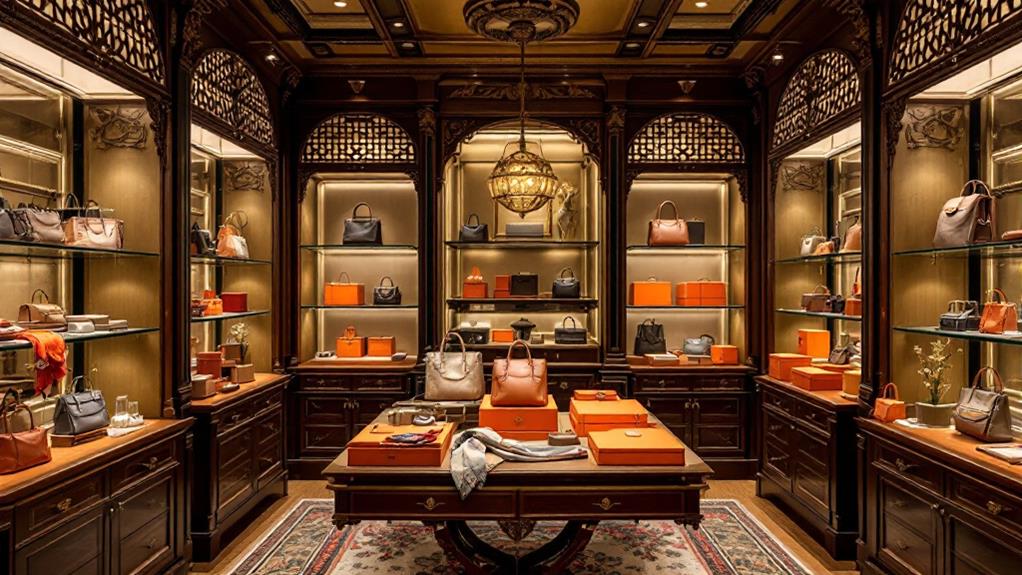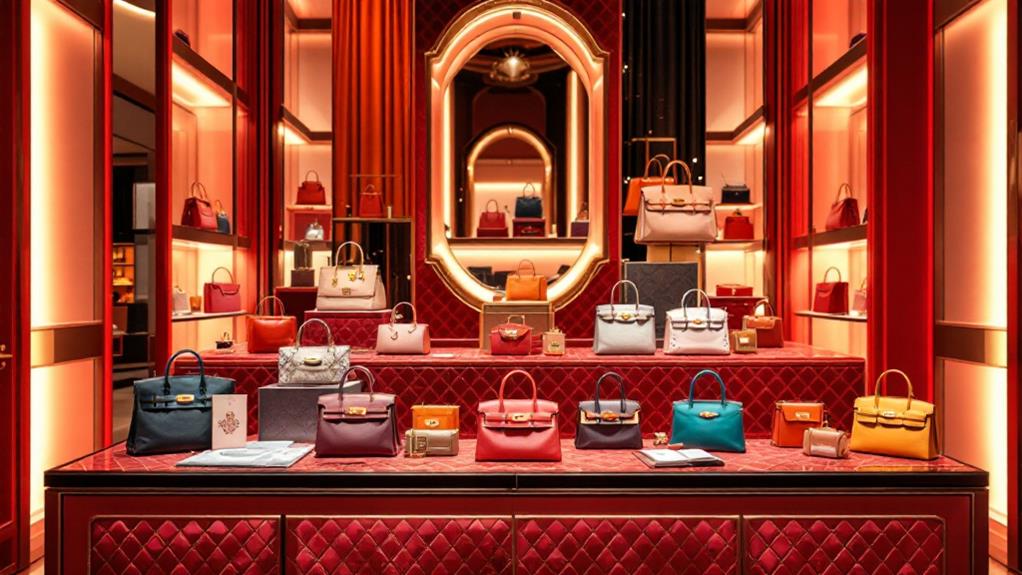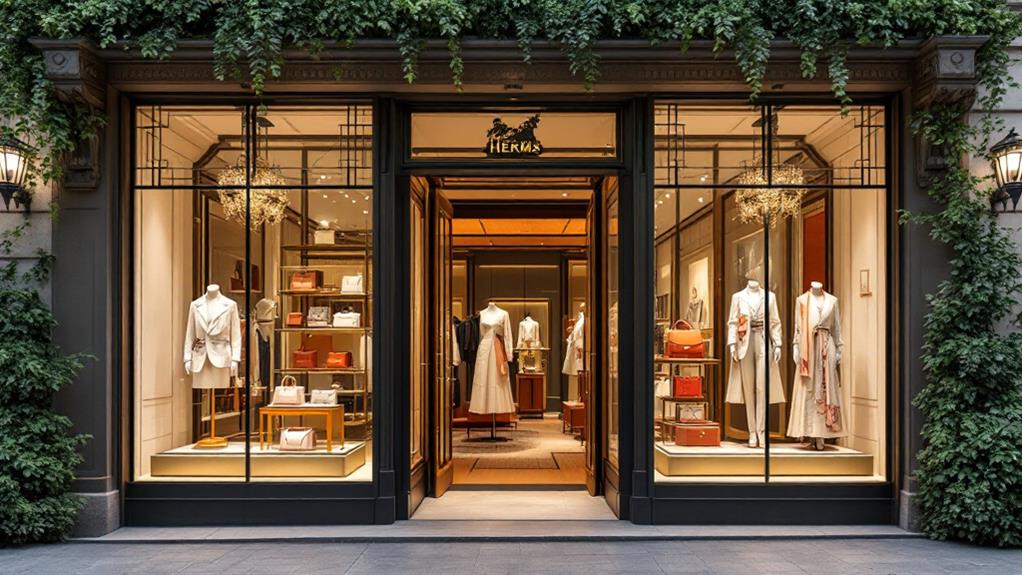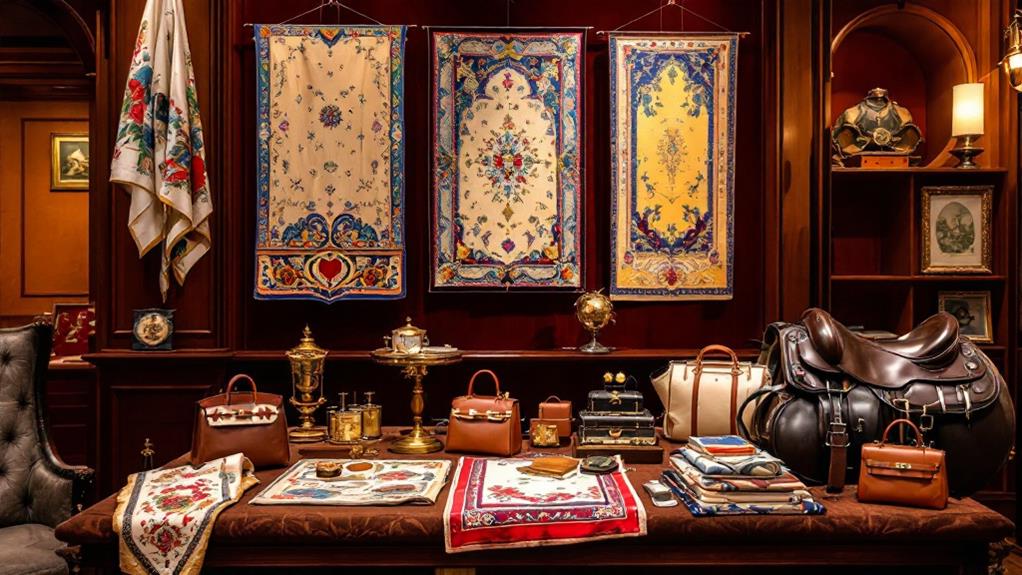Luxury Fashion Brand Spotlight: The History of Hermès

You're about to investigate the rich history of Hermès, a brand that started in 1837 with Thierry Hermès crafting high-quality saddles and equestrian gear. Under Charles-Émile Hermès, the brand relocated in 1880, now home to its flagship store in Paris. In the 20th century, Hermès expanded into luxury handbags, particularly the famed Kelly and Birkin bags. Known for its precise craftsmanship, items can take up to 18 hours to create. With a presence in over 250 global outlets, Hermès remains a premier name in luxury fashion. Let's uncover more about Hermès' iconic expedition and influence.
Origins of Hermès
Founded in 1837 by Thierry Hermès, Hermès began its expedition in Paris, crafting high-quality saddles and equestrian accessories for the French aristocracy. As a brand steeped in tradition, Hermès quickly became synonymous with exceptional craftsmanship, creating items that were both functional and luxurious. The careful attention to detail in every stitch set Hermès apart from others, laying the foundation for what would become an iconic name in luxury.
In 1880, Charles-Emile Hermès relocated the company's workshop to the famed 24 rue du Faubourg Saint-Honoré, which remains the flagship store today. This move marked the beginning of Hermès' expansion into new territories. By the early 1900s, Hermès had diversified its product line to include the Haut à Courroies, a practical yet elegant luxury bag designed for carrying saddles. This diversification was an indication of Hermès' ability to blend tradition with innovation.
The introduction of the Sac à Dépêches in 1922 marked Hermès' entry into the world of luxury handbags, evolving eventually into the iconic Kelly bag. This leap into luxury fashion solidified Hermès' reputation for craftsmanship, attracting global elites and celebrity endorsements, making its products symbols of prestige and exclusivity.
Transformative Leadership
Transformative leadership has been the cornerstone of Hermès' enduring success, guiding the brand through evolving markets and trends. It all began with Thierry Hermès in 1837, whose dedication to craftsmanship set a robust foundation for the luxury brand. When Charles-Émile Hermès took the reins in 1878, he relocated the workshop to a prestigious Paris address, elevating Hermès from a local business to a luxury goods brand known worldwide. This strategic move marked the beginning of Hermès' transformation into a symbol of luxury.
Fast forward to 1978, and you see Jean-Louis Dumas stepping in as a transformative leader who expanded Hermès' global presence. His groundbreaking approach introduced iconic products, breathing new life into the brand's identity. Under his leadership, Hermès didn't just sell products; it sold a lifestyle steeped in quality and elegance. Subsequent creative directors like Martin Margiela and Jean Paul Gaultier continued this legacy by blending traditional craftsmanship with contemporary designs, ensuring Hermès stayed at the forefront of fashion.
The Hermès family's active involvement keeps the brand's legacy intact, influencing strategic decisions and maintaining their unique blend of time-honored craftsmanship and modern luxury.
Iconic Handbag Designs

Hermès' legacy of transformative leadership seamlessly extends into its iconic handbag designs, where history and innovation meet in perfect harmony. The story commences with the Haut à Courroies (HAC), Hermès' initial haute couture handbag, initially created to carry saddles. This design laid the groundwork for the creation of the luxury icons that are recognized today: the Kelly and Birkin bags.
The Kelly bag, once known as the Sac à Dépêches, was redefined by Robert Dumas-Hermès. It skyrocketed to fame in the 1950s when actress Grace Kelly was frequently seen with it, cementing its status as a symbol of luxury and elegance. The Kelly's streamlined design and association with Hollywood royalty make it a timeless classic.
On the other hand, the Birkin bag emerged from a fortuitous encounter between Jane Birkin and Jean-Louis Dumas in 1984. This bag perfectly balances functionality and exclusivity, addressing the modern woman's needs. Its design and limited availability have made it a coveted luxury item, with prices ranging from €6,813 to €78,620, particularly for rare editions.
Both bags are not just accessories; they're investments in style, heritage, and luxury.
Craftsmanship and Quality
Craftsmanship at Hermès, through and through, is an art form that combines precision and passion, resulting in unparalleled quality. Every Hermès creation, especially their renowned leather goods, showcases this dedication. Skilled artisans carefully handcraft each product, ensuring that every detail is perfect. A single Hermès bag can take up to 18 hours to complete, underscoring the time and expertise invested in each piece. This dedication to craftsmanship guarantees that every Hermès item is not just a purchase but a long-lasting gem.
Quality control at Hermès is uncompromising. The brand implements rigorous measures to maintain its high standards. If an item doesn't meet their exacting criteria, it's destroyed, ensuring only flawless goods reach customers. This commitment to excellence upholds Hermès' reputation and assures you of the impeccable quality of your purchase.
The materials used are sourced globally, with raw materials selected for their premium quality. For instance, their silk scarves are made from proprietary mulberry moth cocoons. This dedication to sourcing the finest materials, combined with the careful craftsmanship, explains why Hermès handbags start at approximately €6,813—reflecting their unmatched quality and exclusivity.
Brand Expansion

As Hermès honed its craftsmanship and quality, the brand's vision expanded beyond equestrian goods, leading to a remarkable evolution in its product offerings. In the early 20th century, Hermès ventured into new territories of the luxury market by introducing luxury handbags, clothing, and accessories. This strategic expansion greatly broadened its market appeal and allowed Hermès to establish itself as a versatile luxury brand.
One crucial moment in Hermès' expansion was its entry into the U.S. market. In 1924, Hermès began selling its products at French seaside resorts, paving the way for its American debut. By 1930, Hermès products were available at Neiman Marcus, marking a notable milestone in its expansion strategy. These moves not only increased brand visibility but also cemented Hermès' reputation as a global luxury powerhouse.
Further solidifying its global footprint, Hermès opened stores in key locations like New York City and London during the late 20th century. The brand's creative approach, such as creating the initial leather golf jacket for Edward, Prince of Wales, showcased its dedication to diversification. By 2019, Hermès' successful expansion strategy was evident as it ranked 33rd among Forbes' most valuable brands.
Market Presence
With a robust international presence, Hermès features over 250 retail outlets worldwide, solidifying its status as a global luxury leader. Whether in lively New York City or the chic streets of London, Hermès has firmly embedded itself in key luxury markets. This strategic expansion has been essential in establishing the brand's strong market presence in the competitive world of global fashion. Having ventured into the U.S. market back in 1924, Hermès captured the American consumer's imagination through collaborations with high-end retailers like Neiman Marcus, elevating its visibility and desirability.
In 2019, Forbes ranked Hermès as the 33rd most valuable brand, reflecting its esteemed position among luxury brands. This recognition is mirrored in its financial achievements, with a remarkable turnover of €3.75 billion reported in 2023, and profits soaring to €1.21 billion. Such figures underscore Hermès's dominance and robust market presence within the luxury fashion sector.
Here's why Hermès stands out:
- Global Reach: Over 250 stores improve accessibility worldwide.
- Strategic Partnerships: Collaborations with top retailers heighten brand desirability.
- Impressive Financials: Strong turnover and profits signify market strength.
Embrace Hermès's exquisite offerings and experience true luxury.
Legacy of Exclusivity

Hermès's legacy of exclusivity is rooted in its precise approach to craftsmanship and scarcity. By producing limited quantities of iconic handbags like the Birkin bag, Hermès creates a sense of anticipation and desire that few brands can match. The craftsmanship involved in each piece guarantees that every Birkin bag is unique, which only adds to its allure. This careful attention to detail and quality assures that owning a Hermès product is not merely a transaction but an experience that luxury consumers value.
The exclusivity of the Birkin bag is further amplified by lengthy waitlists that can extend for months or even years. Such scarcity has led to the phenomenon known as "Birkin Bait," where the limited availability creates a buzz that boosts consumer engagement. This strategy greatly contributes to the brand's mystique and status. Prices for Hermès handbags often reflect their exclusive nature, with rare models fetching upwards of €78,620, while vintage or unique Birkin pieces frequently exceed €25,000 at resale.
Hermès has successfully cultivated a strong emotional connection with its clientele. Through storytelling and heritage, the brand positions its products as symbols of status and refined taste, making them highly sought-after valuables.
Philanthropic Initiatives
While Hermès is renowned for its luxury craftsmanship, it also adopts a profound commitment to philanthropy through the Fondation d'entreprise Hermès. Established in 2008, the foundation underscores Hermès' dedication to supporting arts and environmental protection. You'll find that their philanthropic initiatives include exhibitions, prizes for emerging artists, and a variety of cultural projects. These efforts highlight Hermès' focus on creativity and community engagement, guaranteeing that its role in luxury fashion goes beyond mere aesthetics.
Hermès' philanthropic endeavors align seamlessly with its commitment to quality and craftsmanship. The brand practices ethical sourcing and manufacturing, reflecting its dedication to sustainable and responsible business practices. This alignment assures that Hermès' contributions are both impactful and consistent with its values. By maintaining such high standards, Hermès reinforces its reputation as a leader in the luxury fashion industry.
Here are three ways Hermès' philanthropic initiatives boost its cultural relevance:
- Supporting Emerging Artists: Through exhibitions and prizes, Hermès fosters new talent.
- Cultural Projects: These initiatives deepen community ties and promote creativity.
- Sustainable Practices: Hermès' ethical approaches guarantee their initiatives are responsible and meaningful.



